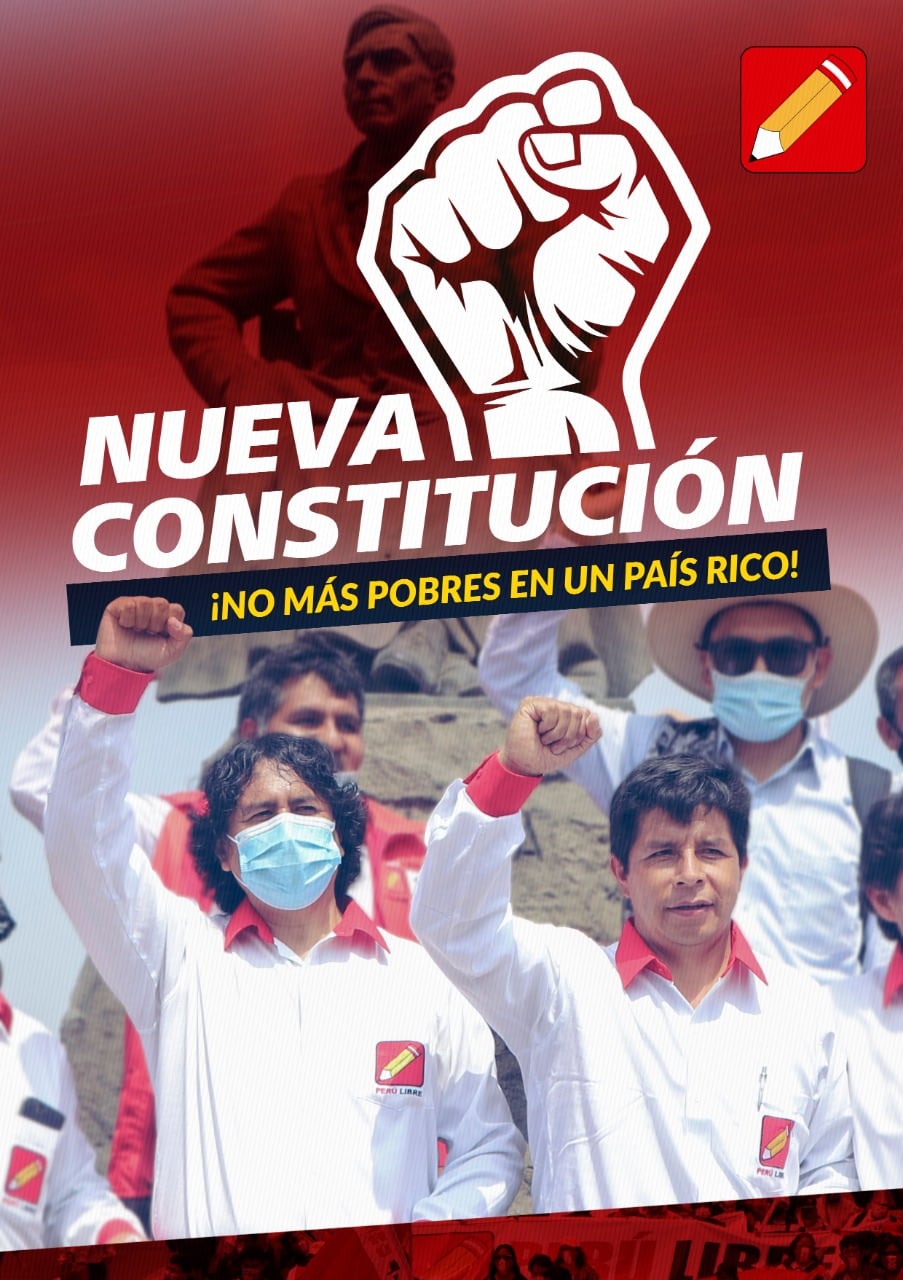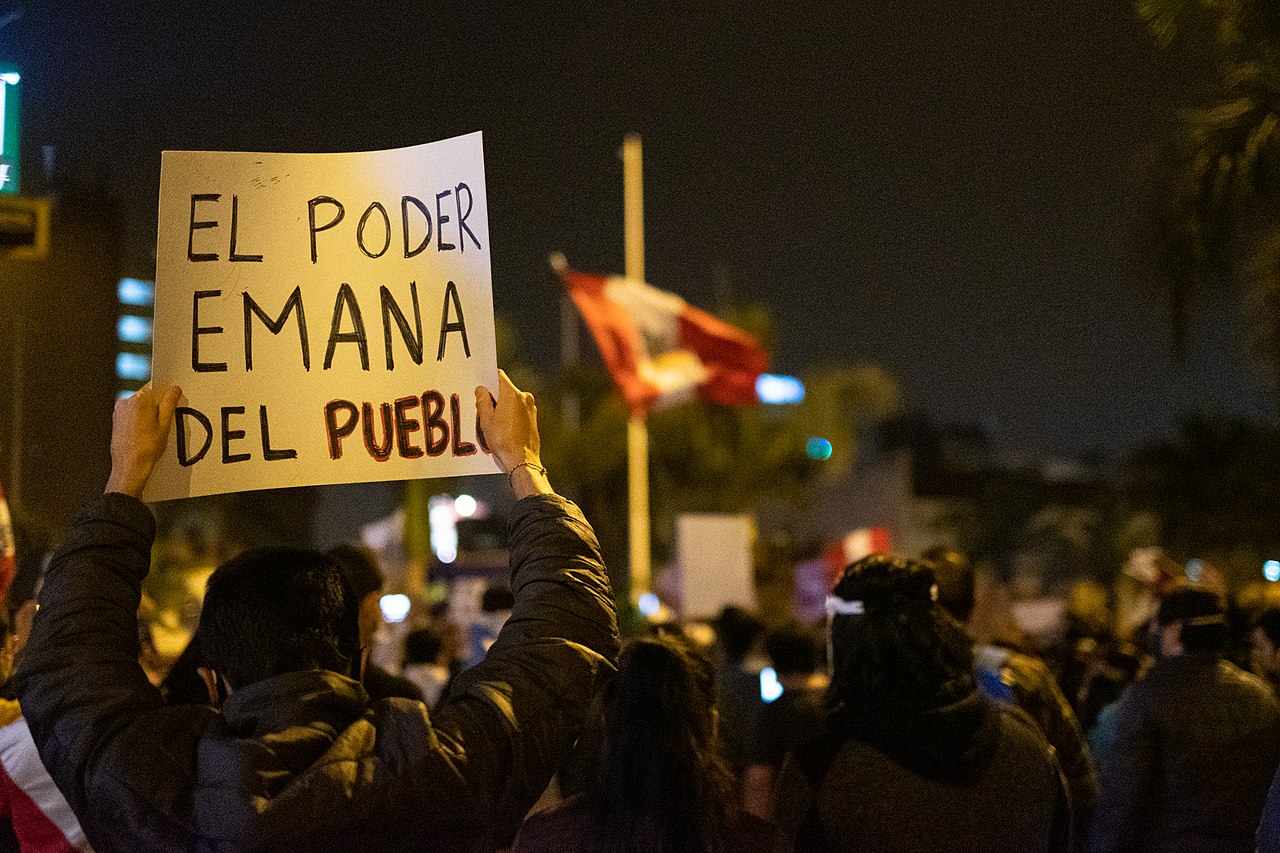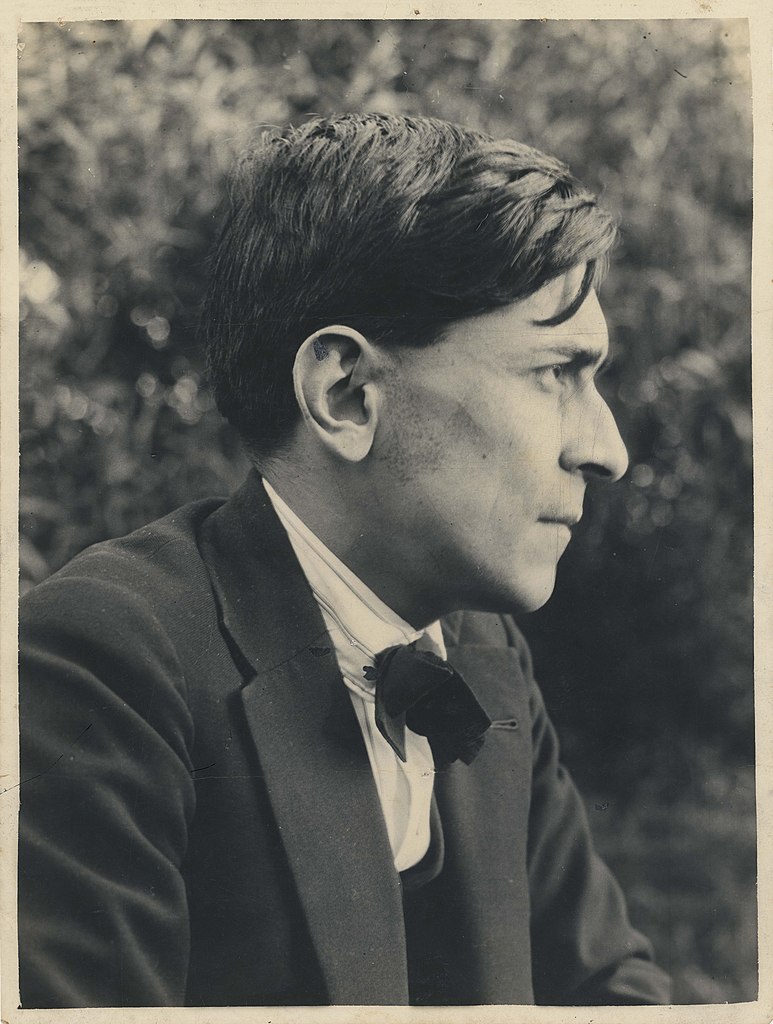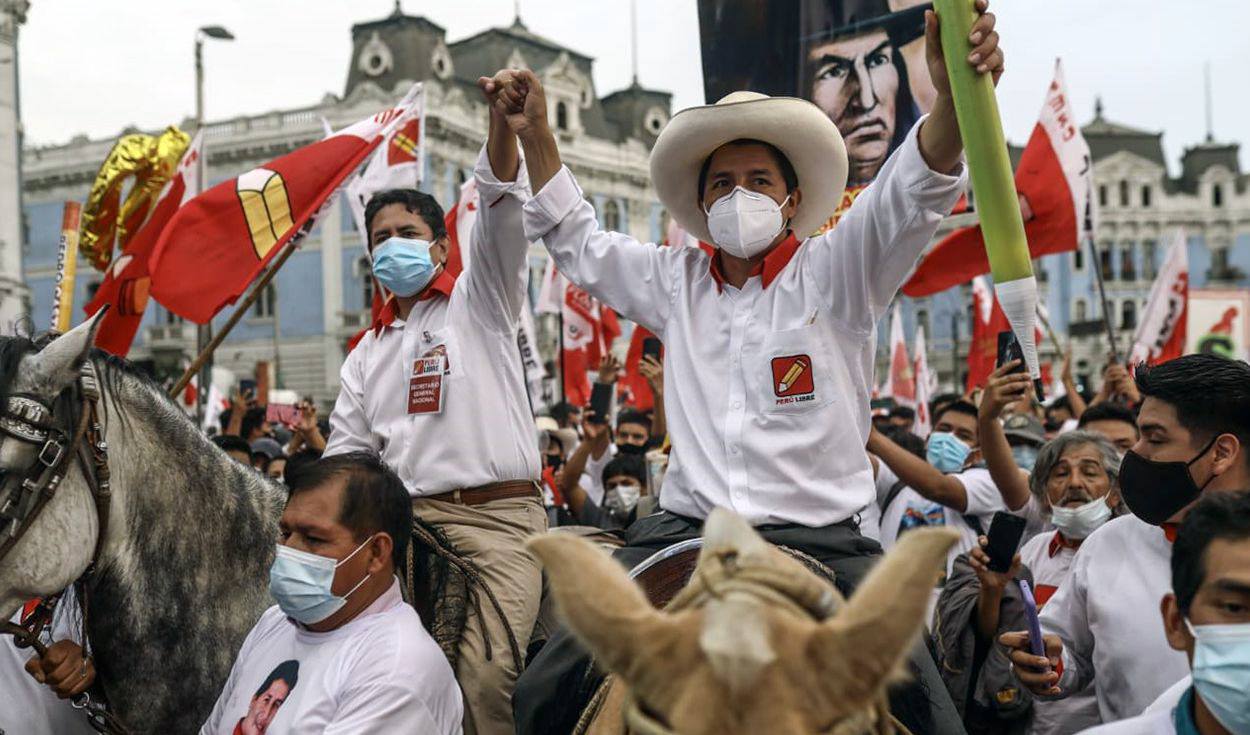On Sunday 11 April, the first round of the presidential elections in Peru produced a major surprise: the victory, against all the odds, of Pedro Castillo, the leader of the 2017 teachers' strike. In the second round, he will face the reactionary, right-wing candidate of Fuerza Popular, Keiko Fujimori, in a clear expression of enormous political polarisation in a country ravaged by the economic crisis and the COVID-19 pandemic.
That Pedro Castillo, from Peru Libre, came first in the first round of the presidential elections is a very significant symptom of the crisis of legitimacy of the bourgeois institutions and parties, a central aspect of the crisis of the regime that Peru is experiencing. This was also expressed in the explosive mobilisations in November, when the eruption of the masses broke the fragile institutional balance.
Pedro Castillo is known for being a trade union militant who led the all-out teachers’ strike of 2017, in a rebellion of the rank and file against the bureaucratic and submissive leadership of the SUTEP union (controlled by the Communist Party of Peru – Red Homeland).
One of the central slogans of his campaign – “No more poor in a rich country” – expresses the enormous anger accumulated among the masses of Peru against the capitalists, the multinationals, and the political elites that represent their interests. The ruling class in Peru is also permeated by racism and class contempt towards the indigenous people, towards the poor working-class and peasant masses of the regions, and also towards those living in the rural areas. Peru Libre describes itself as a ‘Marxist-Leninist-Mariateguist’ party, and openly uses the word ‘socialist’ in its programme and agitation.
The call for a Constituent Assembly, which has been a central point of the party’s campaign, connects very well with the general rejection, not only of the current constitution, drawn up under the Fujimori dictatorship, but of all the rotten and corrupt institutions of bourgeois democracy. Castillo has declared that if Congress does not accept the call for a Constituent Assembly, he will disband it.
Along the same lines, he has promised to dissolve the Constitutional Court, implicated in corruption scandals, and to elect a new one “by popular mandate where each one of the magistrates will not depend on a parliament that serves political and economic interests of their own; they will have to become true tribunes of the people to defend not a mafia constitution, but the rights of the people.”
 Castillo's call for a Constitutional Assembly resonates not only with the rejection of the dictatorship-era constitution, but of the whole regime / Image: Vladimir Cerrón
Castillo's call for a Constitutional Assembly resonates not only with the rejection of the dictatorship-era constitution, but of the whole regime / Image: Vladimir Cerrón
This language of head-on confrontation against the corrupt bourgeois institutions is what has won the teachers’ union leader the support of important sectors of the working class, teachers and poor peasants in the country's provinces – not only in his native Cajamarca, in the north, but also throughout the southern Andean region.
Castillo's victory represents a vote for the candidate who appears the most far-removed and opposed to official policy. The union militant has announced that he will renounce his salary as president and will live on his teacher’s wage and that he will cut the salaries of ministers, congressmen, and senior public officials by half.
His programme also announces the nationalisation of, “Camisea gas for all families in Peru. Oil wells, gold, silver, Machu Picchu and Peru Rail must be recovered.” He proposes the revision of all contracts with multinationals so that instead of receiving 70% of the profits and leaving 30% to the state, it will be the other way around. With this money he proposes to finance an ambitious programme of investment and public services, dedicating 10% of the national budget to education, organising a literacy campaign, and guaranteeing the right to healthcare.
With such a programme, it is not surprising that the bourgeois media joined in a chorus to denounce him and accuse him (falsely) of being linked to Shining Path, the left-wing guerrilla movement in the 1980s and 1990s. The accusation has no basis. Castillo belonged to and vindicates the peasant rondas, self-defence organisations born in his native province of Chota, in Cajamarca, to defend the peasants from crime and also from the penetration of the Shining Path guerrillas.
In reality, the political organisation that the media accuses of being Shining Path’s political arm today – the Movement for Amnesty and Fundamental Rights (Movadef) – called for a spoiled ballot or abstention in the elections. In reply to the accusations, Castillo responded, “when you are telling the truth, they call you a terrorist. Terrorism is hunger, it is misery, it is abandonment, it is the great inequalities, injustices that are committed in the country”. In any case, this situation reveals that the ruling class can no longer have the same impact that they might have had in the past by stirring up the spectre of terrorism.
The surprise victory of Castillo in the first round, a candidate the media labels “ultra-left”, can only be understood as a result of the deep crisis of the regime in Peru. The last five presidents of the country have been indicted for corruption, four of them for having received bribes from the Brazilian public works giant, Odebrecht. Alan García committed suicide in 2019 amid accusations of corruption. Alejandro Toledo is imprisoned in the US pending an extradition request. Pedro Pablo Kuczynski is serving house arrest, convicted of money laundering. Martín Vizcarra, the ‘anti-corruption’ president, was also fired, with accusations of corruption, in a parliamentary manoeuvre that unleashed the mass movement last November. The former nationalist president Ollanta Humala is also being investigated in relation to the Odebrecht case. The dictator Alberto Fujimori completes the list, imprisoned as he is for various crimes, including corruption.
Economic crisis and pandemic
Peru is a rich country, as Castillo points out, which benefited for almost 15 years from the upward cycle of mineral and raw material prices. Between 2003 and 2014, GDP multiplied by four, and GDP per capita also increased by a factor of three. However, this increase in wealth only deepened the polarisation between the rich and poor, in a veritable orgy of corruption and easy money that the elites stuffed into their pockets.
 Growing mass anger, over the handling of the pandemic and the suffering caused by the economic crisis, exploded onto the scene in November last year / Image: Samantha Hare, Flickr
Growing mass anger, over the handling of the pandemic and the suffering caused by the economic crisis, exploded onto the scene in November last year / Image: Samantha Hare, Flickr
In the last year, Peru has been devastated by the economic crisis and by the COVID-19 pandemic. The disastrous management of the pandemic by the government has led to appalling official figures that list 55,000 deaths, and more than 1.6 million accumulated cases (out of a population of 32 million inhabitants). Peru is the country in the world with the highest percentage of excess deaths (140% compared to a normal year), and the country in the world with the highest number of deaths per million inhabitants. If the parameter of excess deaths were used to estimate the actual COVID-19 death toll, we arrive at a figure of 150,000 deaths.
To add insult to injury the country’s politicians have been embroiled in the ‘vaccinagate’ scandal, in which senior government officials were vaccinated before the rest of the population, jumping the queue of medical priorities, and secretly using doses that were intended for clinical analysis.
In 2020, GDP fell by 11.1%, the worst recession in 30 years, making Peru the second worst-hit country in all of Latin America. Two million jobs were destroyed, doubling the unemployment rate to 14.5%. These figures only reflect formal employment, in a country where 70% of workers do not have a contract. 1.8 million people swelled the ranks of those regarded as in poverty. 27.5% of the population is officially classed as in poverty, an increase of 6 points since 2019.
The areas hardest hit by the crisis and the pandemic have been those that have delivered a higher percentage vote for Castillo: 54% in Huancavelica where poverty exceeds 35%, 51% in Ayacucho, 53% in Apurímac, 44% in his native Cajamarca region where poverty reaches 38% of the population, 47% in Puno, 37% in Cusco (where the other left candidate, Verónika Mendoza from Juntos Por Perú, came second with 20%), etc. In total Castillo won in 17 of the 26 departments of the country, and his worst results were in the capital Lima, where he came fifth with 7.88%.
From the results, it is also necessary to highlight the large number of null votes that are also an expression of how fed up millions of people are with official politics. More than two million white votes were counted (12% of those cast), which would actually place the white vote second in the presidential race, behind Castillo (who received 2.6 million, 19% of the valid votes cast)
The three parties that formed the last governments of Peru have fallen below the 5% threshold necessary to remain on the electoral register, and have thus been wiped out.
The programme of Peru Libre
In reality, the programme of Peru Libre is not a socialist programme, which would raise the nationalisation of the means of production and the expropriation of the capitalists. It is a nationalist programme that is explicitly inspired by the experience of the Evo Morales government in Bolivia, and that of Rafael Correa in Ecuador. Its programme is based on the idea of using the country's natural resources to finance national development, and the health and education of the people.
It proposes to reverse the contracts with the multinationals, and only if they refuse to then nationalise them. Despite the use of words like ‘Marxism’ and ‘socialism’, it is a reformist programme, which remains within the limits of the system, and speaks of rejecting “neoliberalism” but of backing the “national business community”.
The main problem is that the limits of the system, in a country dominated by imperialism like Peru, and in the midst of an unprecedented global economic crisis of capitalism like the one we are experiencing, are very, very narrow.
If Castillo wins the presidential election and tries to implement the programme he defends, he will inevitably face the virulent reaction of the capitalists and of imperialism, to whose interests and privileges even this limited programme is a threat. It is not simply a threat because of its promise to reverse relations with multinationals. It also represents a threat because of the expectations it can raise among the majority of workers and poor peasants. In a situation like the one the country is already experiencing, of social effervescence, what the ruling class fears most is that a confrontation between itself and a Castillo government could open the way for mass action in the streets by the workers and peasants.
It is important to mention that there are also other aspects of the Peru Libre programme that reflect reactionary prejudices, such as opposition to equal marriage; xenophobic attacks on “criminal” foreigners, which it says “should be expelled”; the rejection of a supposed “gender ideology”, and its unclear position on abortion rights (Castillo has publicly rejected them, then saying it would be a matter for the Constituent Assembly to decide, whilst the official programme speaks of “decriminalisation” of abortion). Those need to be combatted.
In these respects, Castillo is at the opposite extreme to the other candidate on the left, Verónika Mendoza from Juntos Por Perú, who puts all emphasis on issues of democratic rights and identity, whilst at the same time watering down her programme and trying to appease businessmen (whom she called “strategic allies for the development of the country”). It is no coincidence that, as the campaign progressed and Mendoza watered her programme down, her voting intention dropped and Castillo's increased.
Another aspect that undermined Veronika Mendoza’s campaign was its lack of connection with the concrete struggles of the workers (despite having the official support of the CGTP leadership). In contrast, this was very clear in the case of Castillo, whose authority flows largely from his leading role in the all-out teacher strike of 2017, against the bureaucratic leadership of the union. In short, Mendoza didn’t manage to connect with the most oppressed layers of the workers and peasants of Peru, whilst her language and proposals connected more with urban youth.
Under pressure from bourgeois public opinion, Mendoza rushed to distance herself from Venezuela, denouncing “the dictatorship” of Maduro, while Castillo has refused to make concessions and has expressed his support for Venezuela in the face of imperialism.
 Whilst the Peru Libre party describes itself as Mariatueguist, José Mariatuegui was clear that the tasks of the revolution are explicitly socialist tasks / Image: José Malanca
Whilst the Peru Libre party describes itself as Mariatueguist, José Mariatuegui was clear that the tasks of the revolution are explicitly socialist tasks / Image: José Malanca
Finally, it should be mentioned that the political positions of the leader of Peru Libre, Vladimir Cerrón, include a strong element inherited from the Stalinist-Maoist two-stage theory. This is combined with aberrant positions, such as his open support for Stalin and Putin, whom he places on the same plane. He holds these views, despite the fact that the party claims to be Mariateguist. These views are directly contrary to the thought of Mariátegui, who in Anniversary and balance clearly explained: “The Latin American Revolution will be nothing more and nothing less than a stage, a stage of the world revolution. It will simply and clearly be the socialist revolution. Add all the adjectives you want to this word according to the particular case: ‘anti-imperialist’, ‘agrarian’, ‘national-revolutionary’. Socialism supposes, precedes, and includes all of them.” (see Mariátegui and the permanent revolution)
The second round
The second round will pit Pedro Castillo against the candidate of the Fujimori right wing, Keiko Fujimori. This is a reflection of the sharp political polarisation in Peru, and the collapse of the centerground.
The ruling class will try to defeat Castillo by all means, although Fujimori only represents one wing of the ruling class. At the same time, given the possibility that Castillo could win the elections and become president, they are going to exert all possible pressure on him to moderate his programme and language. We can already see signs of this. In one of his first post-election statements, Castillo declared: “Enough of models, do not lock yourself up, do not lock yourself in, do not isolate yourself [...] I think you don't have to think in terms of the right or the left, because that is too narrow, too small, for the great problems that the country faces.”
We have to say clearly that the crisis Peru is facing is part of the world crisis of capitalism. Capitalism is the cause of the crisis, not corruption, nor ‘neoliberalism’, which are only expressions and symptoms of it. The solution therefore is not to change the Constitution, although it is certainly a scandal that the Fujimori Constitution of 1993 is still in force. The solution is not even to change the contracts with the multinationals. The question is not one of smoothing the rough edges of the system. It is the system itself that is rotten to the core and needs to be overthrown.
 Wide layers of workers and peasants in Peru, through Castillo's candidacy, are seeking solutions to the hardships that they face / Image: Vladimir Cerrón
Wide layers of workers and peasants in Peru, through Castillo's candidacy, are seeking solutions to the hardships that they face / Image: Vladimir Cerrón
The solution is in the first place to put the country's wealth in the hands of the working class. That requires the nationalisation of the multinationals, as well as the expropriation of the large business groups represented in CONFIEP. Only on this basis can we ensure “there are no poor in a rich country”. For that, the working class has to rule with the support of the poor peasantry on the basis of a revolutionary and internationalist perspective.
To the extent that there is no clear revolutionary socialist alternative, it is obvious that wide layers of workers and peasants have expressed and will express their rejection of the established order and their search for solutions that favour the interests of the majority through Castillo's candidacy.
That is going to be a necessary stage in the process of raising the consciousness of the workers. The masses are going to have to put the ideas and programme of Castillo and Peru Libre to the test. Revolutionary Marxists are duty-bound to accompany the masses in this experience, shoulder-to-shoulder, patiently explaining the limitations of this programme, encouraging the masses to rely only on their own strength, helping them draw the necessary conclusions.
No more poor in a rich country, expropriate the multinationals and the capitalists, for a programme of socialist revolution.
